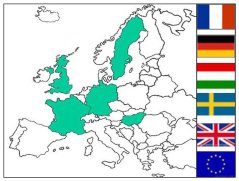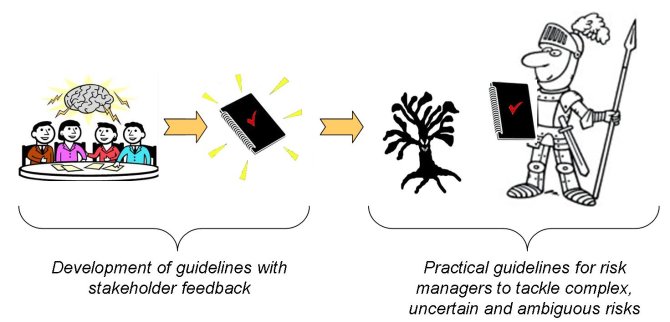
Work package 5
"Investigation of the Institutional Challenges and Solutions to Systemic Risk Management."
The European Community and its Member States increasingly recognize the food safety area as an important risk management priority. There are several main reasons for this:
- During the past decades, the diversity in food supply has significantly increased, due to new production methods, the advancement of food science, and progress in food technology. Consumers can choose from a much greater variety of foods, including novel foods.
- In Europe, a series of food safety incidents (such as BSE) over the past one and a half decades led to significant reductions in the levels of confidence in food safety and the competence of the authorities formally charged with risk management.
- Increased mobility and trade imply the need for action at a global level.
- Issues of food safety and consumer protection are of increasing concern to the general public, civil society organizations and international trading partners.
Faced with these challenges, the EU and many Member States have decided to re-examine food safety policy and to re-structure institutional risk regulation. In several cases there have been major institutional changes since the turning point of the BSE crisis. These include for example the establishment of new food safety agencies in France (Agence Francaise de la Sécurité Sanitaire des Aliments, AFFSA) and the UK (Food Standards Agency, FSA).
Against this background Work package 5 - coordinated by the German partners from DIALOGIK - of the SAFE FOODS project has set as its task to review existing national and European management practices that deal with the multiple challenges that might be associated with food risks. In a next step, Work package 5 proposed suggestions for improving the current structures and procedures.
Based on this work, our risk governance experts in SAFE FOODS have developed new concepts for food risk analysis, giving special attention to the involvement and participation of stakeholders and consumers. This is being done in order to achieve a greater transparency throughout the whole risk analysis process. In a next step, these theoretical concepts are discussed and tested in a series of workshops with stakeholders (industry, risk assessors, risk managers, NGOs).
Finally, this Work package 5 input is integrated into the overarching Work package 6 work: the development of a new, integrated risk analysis approach for foods.
Goals
- To explore current institutional arrangements of food safety regulation in Europe
- To develop guidelines for food risk regulators for dealing with complex, uncertain and socio-politically ambiguous risks
Questions and progress
1. How is food safety regulation organised?
Objectives
The main objective of Work package 5 in SAFE FOODS is to make an institutional review, comparing the responsible institutions in five EU Member States and at the EU level.
The goal of this comparative study is:
- To identify key aspects of the current arrangements of food safety regulation in five EU Member States and at EU-level
- To describe changes in regulatory procedures and structures in the past five to ten years, and to analyse the causes of these changes
- To present suggestions for improving the current structures and procedures and possible further reforms for improving the architecture of food safety regulation in Europe

Furthermore, as part of this inventory, Work package 5 has selected four specific food safety risk cases in order to compare the differences in arrangements made by these countries to regulate the risks.The cases that were investigated are:
- Pesticide residues
- Afiatoxins (a type of mycotoxins which are toxic chemical substances produced by certain form of mould; they are known to cause liver cancer)
- Genetically modified food
- Campylobacter (foodborne bacterium that can cause food poisoning)
Approach
The Work package 5 team has used two sources of information for the institutional review:
- Literature and document research
- Interviews with senior managers and desk-level officials
To ensure comparability of the results of the studies, the Work package 5 researchers started off with developing a research template, based on a focused literature review and an expert consultation.
This research template was presented to experts in the field at the workshop "European Food Safety Regulation under Review", which was organised in July 2004 in Stuttgart. After the workshop, the draft was further refined and elaborated according to the experts’ comments and suggestions.
This research template provided an analytical guideline for the national studies and the EU level study, placing the focus of the review on:
- The allocation of risk assessment and risk management responsibilities
- Improvement of:
a. transparency throughout the risk analysis process
b. public and stakeholder involvement - Scientific uncertainties which are associated with food risks
The key questions which the institutional review addresses include:
- Which agencies or organisations are charged with the different tasks of regulating food risks?
- Which authorities assess the risk (characterising them scientifically) and which manage the risk (decide on the measures to be taken)?
- How do these authorities coordinate their tasks and work?
- What kind of expertise do the authorities use to support their statements and decisions?
- What do they do if experts come up with different conclusions?
- Which facets of a risk issue do the risk managers consider (safety, economic, social, cultural, ethical), and how do they integrate or prioritise these aspects?
- Do the authorities make an effort to listen to the concerns and wishes of the consumers and stakeholders (e.g. retailers, NGOs)?
- Do the authorities involve these actors in the regulatory process?
Results
The table below gives an overview of the intensity of the reform and the rationale of the institutional review.
| Food safety system | Intensity of reform | Rationale |
|---|---|---|
| France | High | Improving effectiveness of food safety system |
| Germany | High | Restoring consumer’s trust |
| Hungary | High | Adaptation of EU law and food safety risk policy approach into national legislation |
| Sweden | Low | Adaptation of EU food safety risk policy approach |
| UK | High | Restoring consumer’s trust |
| EU | High | Restoring consumer’s trust |
Some observations
France, Germany and the United Kingdom have followed different approaches in restructuring the existing regulatory system.
Reforms in these countries include:
- Separation of risk assessment and risk management responsibilities (in France and Germany at the institutional level, in the UK at the functional level)
- Approval of the “Precautionary Principle” which basically deals with:
o Scientific uncertainties
o Recognising the limitations of quantitative approaches in risk assessment - Improved transparency by means of public documentation
- Increased stakeholder consultation opportunities
- Increased targeted risk information addressing major consumer concerns
The Swedish case indicates that food safety scandals, public mistrust in food safety regulation, and pressure to restructure the regulatory system have not reached all EU countries. In Sweden there have been little changes to the regulatory system since its establishment in 1972, and the ordinary citizen does not seem to be concerned about food safety. For example, the country successfully managed to maintain public trust and confidence in the recent BSE food safety crisis. Because of this, hardly any further effort has been invested in opening the risk analysis process to public scrutiny.
Hungary is a new member state which needed to adapt to new EU regulations. This country has had a strong tradition of paternalism, nevertheless trust issues have been gaining relevance in recent times.
Finally, an interesting observation was made by the Work package 5 researchers carrying out the EU-level study. They found that the majority of reforms at this level concentrate on the risk assessment phase and much less relate to the stage of risk management. There are, for instance, clear guiding principles for risk assessment (independence, transparency, excellence), but not for risk management and risk evaluation.
This project task is on its way to completion. The results of this investigation have been compiled in a book that has been published in the beginning of 2007. SAFE FOODS partners from the University of Maastricht (UM) in The Netherlands are in charge of this publication: Ellen Vos & Frank Wendler, “Food Safety Regulation in Europe: A Comparative Institutional Analysis”, Intersentia Publishing (Series Ius Commune).
2. Development of guidelines
Objectives
In parallel with this empirical work, Work package 5 aims to develop a new concept for food risk analysis. This concept shall work as a guideline for risk regulators for dealing with complex and uncertain risks and risks where the available factual information is interpreted very differently by different groups. We refer to these latter risks as ‘ambiguous’ risks; they may trigger public and political controversy and conflict.
Moreover, the guidelines that Work package 5 aims to develop should give advice how to deal with systemic risks, risks which produce effects beyond the original scope of impacts. A good example of a systemic risk is BSE: Although the physical risk to human health has turned out to be relatively small, the repercussions on financial, economic, political and social affairs were tremendous.
Approach
The work in this core task started with a workshop in October 2004 in Pforzheim, Germany, entitled "Systemic Food Risks: a New Challenge to Risk Assessment and Risk Management". The Work package 5 team presented the first draft of a concept for dealing with systemic food risks to experts in the field of risk and government's research. A concept was developed by members of the Work package 5 team in an earlier EU-funded project (PricauPri, 5th Framework Programme) which dealt with the application of the precautionary principle in the European Union.
Their comments (e.g. need for clarifications and specifications in order to be applicable to the food area) have been taken into account and provided a firm basis for the further development of the concept.
The last phase of this project is crucial since it is here that the theoretical concept will be put to the test. Work package 5 has included a series of workshops which will be used to promote feedback from major stakeholders in order to determine if the guidelines are also applicable in practice. The workshops are divided as follows:
• Industry workshop• NGOs workshop
• Risk managers workshop
• Risk assessors workshop
• “Mixed” final workshop (with representatives from the prior workshops)
Gathered feedback from these workshops will be taken into account and included in the final guideline for the regulation of systemic risks.

This phase of the project is being implemented by all three partners DIALOGIK, University of Sussex and University of Maastricht and is expected to be finalised shortly (2007).
Results
The most relevant points that are currently being addressed are:
- How to better explain and deal with scientific uncertainty and socio-political ambiguity in risk assessment and risk management phases
- How to develop clearer structures of participation of stakeholders and the general public
- How to better deal with the common boundaries and interfaces between risk assessment and risk management in a more systematic, transparent and inclusive way
Finally, the proposed guidelines for food risk regulators developed within Work package 5 will be integrated in the final SAFE FOODS Risk Analysis Framework, which is developed by the SAFE FOODS experts in Work package 6.